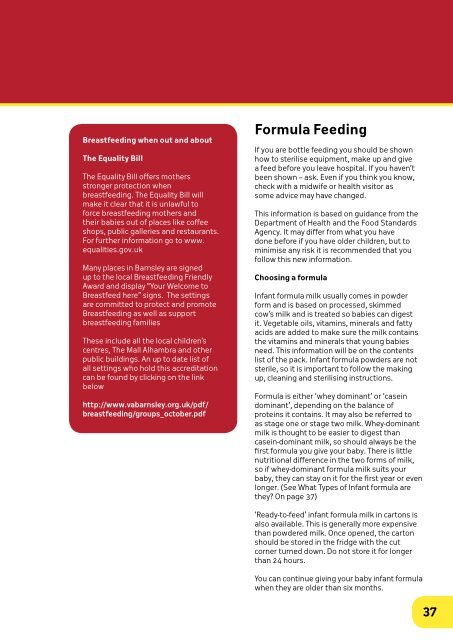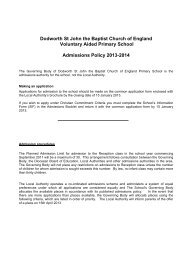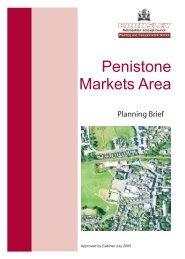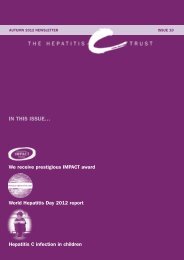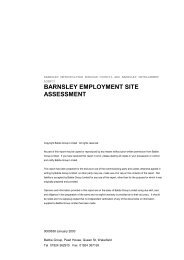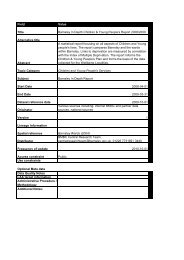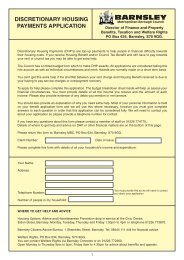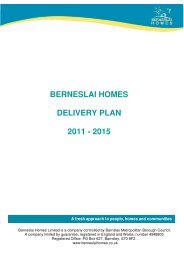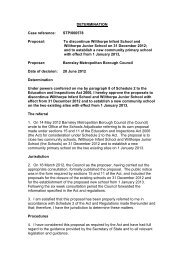Food and Nutrition Guidelines - Barnsley Council Online
Food and Nutrition Guidelines - Barnsley Council Online
Food and Nutrition Guidelines - Barnsley Council Online
You also want an ePaper? Increase the reach of your titles
YUMPU automatically turns print PDFs into web optimized ePapers that Google loves.
Breastfeeding when out <strong>and</strong> about<br />
The Equality Bill<br />
The Equality Bill offers mothers<br />
stronger protection when<br />
breastfeeding. The Equality Bill will<br />
make it clear that it is unlawful to<br />
force breastfeeding mothers <strong>and</strong><br />
their babies out of places like coffee<br />
shops, public galleries <strong>and</strong> restaurants.<br />
For further information go to www.<br />
equalities.gov.uk<br />
Many places in <strong>Barnsley</strong> are signed<br />
up to the local Breastfeeding Friendly<br />
Award <strong>and</strong> display “Your Welcome to<br />
Breastfeed here” signs. The settings<br />
are committed to protect <strong>and</strong> promote<br />
Breastfeeding as well as support<br />
breastfeeding families<br />
These include all the local children’s<br />
centres, The Mall Alhambra <strong>and</strong> other<br />
public buildings. An up to date list of<br />
all settings who hold this accreditation<br />
can be found by clicking on the link<br />
below<br />
http://www.vabarnsley.org.uk/pdf/<br />
breastfeeding/groups_october.pdf<br />
Formula Feeding<br />
If you are bottle feeding you should be shown<br />
how to sterilise equipment, make up <strong>and</strong> give<br />
a feed before you leave hospital. If you haven’t<br />
been shown – ask. Even if you think you know,<br />
check with a midwife or health visitor as<br />
some advice may have changed.<br />
This information is based on guidance from the<br />
Department of Health <strong>and</strong> the <strong>Food</strong> St<strong>and</strong>ards<br />
Agency. It may differ from what you have<br />
done before if you have older children, but to<br />
minimise any risk it is recommended that you<br />
follow this new information.<br />
Choosing a formula<br />
Infant formula milk usually comes in powder<br />
form <strong>and</strong> is based on processed, skimmed<br />
cow’s milk <strong>and</strong> is treated so babies can digest<br />
it. Vegetable oils, vitamins, minerals <strong>and</strong> fatty<br />
acids are added to make sure the milk contains<br />
the vitamins <strong>and</strong> minerals that young babies<br />
need. This information will be on the contents<br />
list of the pack. Infant formula powders are not<br />
sterile, so it is important to follow the making<br />
up, cleaning <strong>and</strong> sterilising instructions.<br />
Formula is either ‘whey dominant’ or ‘casein<br />
dominant’, depending on the balance of<br />
proteins it contains. It may also be referred to<br />
as stage one or stage two milk. Whey-dominant<br />
milk is thought to be easier to digest than<br />
casein-dominant milk, so should always be the<br />
first formula you give your baby. There is little<br />
nutritional difference in the two forms of milk,<br />
so if whey-dominant formula milk suits your<br />
baby, they can stay on it for the first year or even<br />
longer. (See What Types of Infant formula are<br />
they? On page 37)<br />
‘Ready-to-feed’ infant formula milk in cartons is<br />
also available. This is generally more expensive<br />
than powdered milk. Once opened, the carton<br />
should be stored in the fridge with the cut<br />
corner turned down. Do not store it for longer<br />
than 24 hours.<br />
You can continue giving your baby infant formula<br />
when they are older than six months.<br />
37


